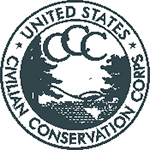History of Parker Dam State Park
When European settlers arrived in Pennsylvania, the Iroquois Confederacy had claimed this land and invited the uprooted Lenni Lenape (Delaware) to occupy it. Eventually loggers and homesteaders moved in, forcing the American Indians to migrate west.
During 1794, Daniel Delany surveyed the impressive forests of white pine, hemlock, and scattered hardwoods. Logging began slowly as small sawmills processed the wood. The light, strong wood of the white pine made it the jewel of early lumbering.
Ship builders in Baltimore prized tall white pine logs for ship masts and paid premium prices. Loggers built white pine rafts and rode them down the Susquehanna River. When all went well, loggers arrived in Baltimore to sell their highly valued logs.
Logging accelerated in 1851 because of a log boom built across the West Branch of the Susquehanna River at Williamsport. The boom stopped floating logs for sorting and cutting by sawmills.
Upriver, “woodhicks” felled trees, cut off their branches, and marked each log with the seal of the lumber company that employed them. Most logging occurred in winter, when a thick layer of snow and ice made hauling easier. Woodhicks built wooden log slides on hillsides to easily move logs to temporary pools called splash dams. A reproduction log slide and early lumbering tools can be seen on the Log Slide Trail.
Splash dams were released each spring to float logs down Laurel Run to Bennetts Branch, then to Sinnemahoning Creek, and then into the West Branch of the Susquehanna River for their journey to the sawmills at Williamsport.
The park takes its name from William Parker, who leased lumbering rights from John Otto. Parker built a splash dam on Laurel Run at the site of the present lake.
Full-scale lumbering in the area probably began around 1870. The forests were cut and recut, first for the white pine and later for hemlock and hardwoods.
During the early 1900s, the log boom at Williamsport became inefficient because geared locomotives moved the logs directly from the forests to the mills. The log boom was dismantled in 1909.
The Central Pennsylvania Lumber Company built logging railroads and logged the park land a final time. Crews loaded up to 45 railroad cars a day until logging ended in the park in 1911. Old railroad grades are still visible on Moose Grade Road, and Spurline, Beaver Dam, and Quehanna hiking trails. For nearly two decades after the last tree was felled, fires and floods plagued the area.
Civilian Conservation Corps

During 1930, the Commonwealth of Pennsylvania began buying land from the Central Pennsylvania Lumber Company for $3.00 an acre. Around the same time, President Franklin Delano Roosevelt started a conservation movement to help stem the Great Depression and restore the nation’s natural resources. He called it the Civilian Conservation Corps (CCC). It employed young men in conservation work and gave them hope.
During 1933, the CCC boys set up camp at the intersection of Tyler and Mud Run roads (Camp S-73-PA). The CCC planted trees, built roads and trails, and constructed the current dam of native sandstone on the site of William Parker's splash dam.
Their handiwork is seen in the stone pavilions and in the Lou and Helen Adams CCC Museum near the breast of the dam. Parker Dam was designated a recreational reserve in 1936.
The CCC and the Works Progress Administration continued improvements, until many CCCers were drafted in 1941 for World War II. Additional information about the CCC work in the park is available from the brochure:
Civilian Conservation Corps at Parker Dam State Park (PDF)
Since the days of the CCC, Parker Dam has changed very little. New facilities have been added and seedlings planted by the CCC have grown into trees. In May of 1985, many of the majestic trees in the park were lost to a tremendous tornado. But, through it all there is a constant; the beauty and serenity of Parker Dam State Park.
Lou and Helen Adams Civilian Conservation Corps Museum
This CCC museum at Parker Dam State Park provides a look back in time to the 1930s and early '40s. Photos, interpretation, videos, and more await to inform the visitor of the life and times of the CCC. The building itself was built by the CCC and functioned as the park office until 1984, when it began its transition to becoming a wonderful interpretive center honoring all the work completed by the men and boys of the Civilian Conservation Corps.
The museum is open to the public Saturdays and Sundays, from 1:00 P.M. until 4:00 P.M. during the summer season -- as volunteers are available. The museum also is available for group tours by appointment by calling the park office.